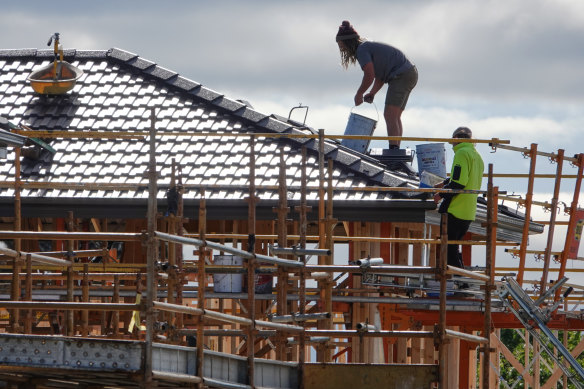A quarter of a million shortfall: Housing target unlikely to be met
By Shane Wright
The federal government will fall 260,000 homes short of its 1.2 million target by the end of the decade, with warnings the nation faces chronic housing affordability problems that will weigh on younger generations for years.
New forecasts from Oxford Economics, released on Monday, show that despite the housing construction market enjoying a pick-up from next year as the Reserve Bank starts to cut official interest rates, the government will miss its ambitious home target by more than 20 per cent.

Home construction is tipped to fall well short of the federal government’s 1.2 million target for mid-2029.Credit: Paul Rovere
Soon after taking office, the government set a target of one million new homes between mid-2024 and mid-2029. It has since lifted that to 1.2 million in a bid to deal with spiralling house prices and rents.
Sydney’s median house value has climbed to almost $1.5 million while Canberra ($986,000), Brisbane ($953,000) and Melbourne ($949,000) are all above $900,000. Asking rents have also soared, climbing by more than 12 per cent in many capitals.
The government has announced more than $30 billion in housing policy including an extra $1 billion to the states to fast-track infrastructure such as sewers and roads, $9.3 billion for more social housing and its $10 billion Housing Australia Future Fund.
But according to Oxford’s head of property and building forecasting, Timothy Hibbert, that won’t be enough for the government to hit its long-term target.
He said total house and apartment starts are on track to slip to just 155,700 this year, the lowest number since 2013 when the nation was home to 23 million. Today, the population has reached 27 million.
High interest rates and high building costs, which had led to the fall in housing starts, would eventually be turned around, Oxford forecasting a record 241,900 starts by mid-2029.
“While we will continue to experience a dwelling stock deficiency, activity will inevitably recover in the residential sector,” he said. “All build forms will contribute, driving total dwelling commencements to a new record level by the end of the decade.”
Australian Bureau of Statistics data last week showed work started on 39,720 new dwellings in the three months to the end of March, a 3.5 per cent drop on the same period last year.
Starts have lifted in Western Australia (up 24.9 per cent) and the ACT (24.7 per cent) but have fallen in all other states and territories. In NSW, they fell by almost 30 per cent while in the Northern Territory, they dropped by 41.2 per cent.
Work on 41,330 homes finished in the March quarter, showing a 9.5 per cent drop on the final three months of 2023. Just 26,800 detached houses were finished in the quarter – a 16.8 per cent fall on the December quarter.
Oxford is tipping housing starts, which have fallen below 100,000 to reach an annual rate of 120,000 by the end of 2026. Starts on apartments, forecast to keep falling to around 54,000 by the middle of next year, are then expected to improve to more than 100,000 by mid-2028.
Hibbert said construction would start to rise next year as a combination of federal and state government programs, lower interest rates and fewer labour shortages enabled builders to get work under way.
He said despite that increase, the shortage of housing would weigh on property prices and “entrench” affordability issues.
Much will hinge on the direction of official interest rates. The Reserve Bank has lifted the cash rate from 0.1 per cent in early 2022 to a 13-year high of 4.35 per cent.
On a $600,000 mortgage, the rise in interest rates has increased repayments by $1500 a month.
Reserve Bank researchers Ryan Morgan and Elena Ryan, in a new paper on the health of the nation’s property market, found the increase in interest rates had translated into a relatively small increase in the number of home buyers behind on their repayments.
The share of borrowers 30 days behind on their loans has increased from 0.8 per cent to 1.4 per cent since the RBA started lifting rates, while the proportion of people 90 days or more behind has lifted from 0.5 per cent to 0.75 per cent.
Morgan and Ryan found people with high loan-to-value mortgages were the most likely to be struggling with repayments. These borrowers almost all had failed to get ahead on their repayments.
But even among this cohort, which remains a small share of total mortgage holders, the arrears rate was just 3 per cent.
The researchers said pressure on household budgets would continue but would ease as inflation slowed, with the biggest issue likely to be the jobs market.
“The expected gradual further labour market easing will be challenging for households who lose work,” they found.
Cut through the noise of federal politics with news, views and expert analysis. Subscribers can sign up to our weekly Inside Politics newsletter.